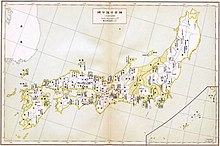Shugo

Shugo(Bảo hộ),commonly translated as “(military) governor,” “protector,” or “constable,” was a title given to certain officials infeudal Japan.They were each appointed by theshogunto oversee one or more of theprovinces of Japan.The position gave way to the emergence of thedaimyo(military feudal lords) in the late 15th century, asshugobegan to claim power over lands themselves, rather than serving simply as governors on behalf of the shogunate.
History
[edit]The post is said to have been created in 1185 by shogunMinamoto no Yoritomoto aid the capture ofYoshitsune,with the additional motivation of extending the rule of the Minamoto shogunate government throughout Japan. Theshugo(military governors) progressively supplanted the existingkokushi(civil governors), who were appointed by theImperial Court in Kyoto.Officially, thegokeninin each province were supposed to serve theshugo,but in practice, the relationship between them was fragile, as the gokenin were vassals of theshōgunas well.
Shugooften stayed for long periods in the capital, far from their province, and were sometimes appointedshugofor several provinces at the same time. In such cases, a deputyshugo,orshugodai( bảo hộ đại ), was appointed.
Over time, the powers of someshugogrew considerably. Around the time of theŌnin War(1467–1477), conflicts betweenshugobecame common.[1]Someshugolost their powers to subordinates such as theshugodai,while others strengthened their grip on their territories. As a result, at the end of the 15th century, the beginning of theSengoku period,the power in the country was divided amongst military lords of various kinds (shugo,shugodai,and others), who came to be calleddaimyōs.
Famousshugoanddaimyōclans of the Muromachi period
[edit]Below is a list of some of the major clans that producedshugosanddaimyōsduring theMuromachiera and Sengoku period, as well as the regions over which they ruled.
- Hosokawa clan–Izumi,Settsu,Tanba,Bitchū,Awaji,Awa,Sanuki,Iyo,andTosaprovinces
- Takeda clan–Kai Province,Aki province,Wakasa Province
- Ōtomo clan–Bungo Province,Buzen Province
- Toki clan–Mino Province
- Rokkaku clan–Ōmi Province
- Ogasawara clan–Shinano Province
References
[edit]- ^Sansom, George (1961).A History of Japan, 1334–1615.Stanford University Press. pp. 200–202, 207.ISBN0804705259.
Further reading
[edit]- Frédéric, Louis (2002).Japan Encyclopedia.Cambridge, Massachusetts: Harvard University Press.
